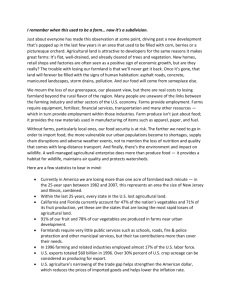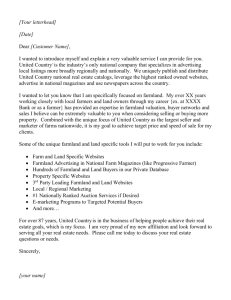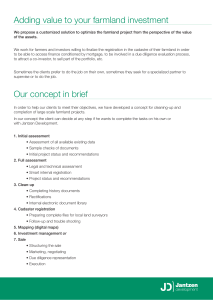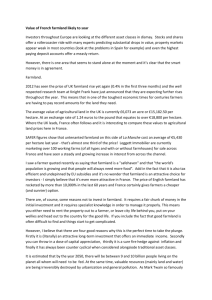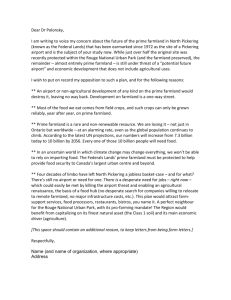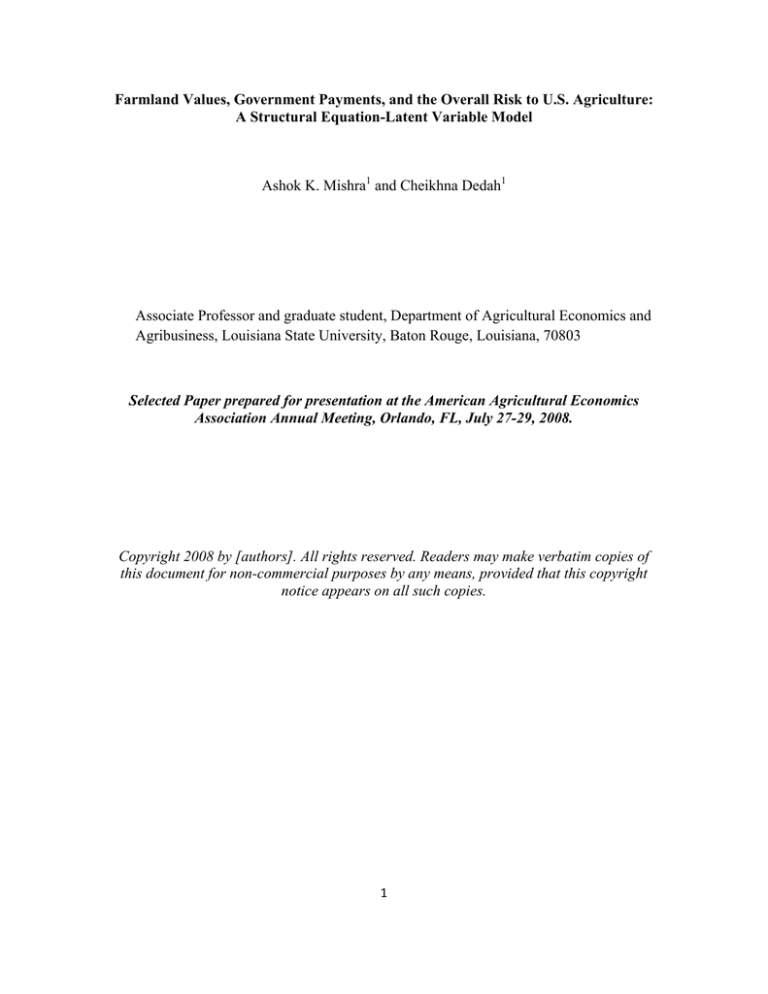
Farmland Values, Government Payments, and the Overall Risk to U.S. Agriculture:
A Structural Equation-Latent Variable Model
Ashok K. Mishra1 and Cheikhna Dedah1
Associate Professor and graduate student, Department of Agricultural Economics and
Agribusiness, Louisiana State University, Baton Rouge, Louisiana, 70803
Selected Paper prepared for presentation at the American Agricultural Economics
Association Annual Meeting, Orlando, FL, July 27-29, 2008.
Copyright 2008 by [authors]. All rights reserved. Readers may make verbatim copies of
this document for non-commercial purposes by any means, provided that this copyright
notice appears on all such copies.
1 Farmland Values, Government Payments, and the Overall Risk to U.S. Agriculture:
A Structural Equation-Latent Variable Model
Abstract
According to Ricardian rent theory, the value of farm assets is equal to the discounted present
value of future expected net rents from farm returns, and the discounted expected value of the
land if converted to nonfarm development. Some recent research has considered modifying this
standard present value model by acknowledging that returns from the market may be discounted
at a different interest rate than returns from government payments (Goodwin, Mishra, and OrtalMagne) and also that the discount rate itself may be time-varying. However, very little research
has considered how changes in the overall risk to agriculture may affect farmland values. An
exception is Moss, Shonkwiler and Schmitz (2004). We use time series panel data from the
USDA for United States, 1960-2004 and a structural equations model with latent variables for
the rate of return on farm assets and for the real risk-adjusted interest rate. We find that a
secondary effect of agricultural policies that reduces the overall risk to agriculture may increase
farmland values (and thus farm sector wealth). Government payments are offsetting the negative
impact of high volatility of returns to farming.
2 Farmland Values Government Payments, and the Overall Risk to U.S. Agriculture:
A Structural Equation-Latent Variable Model
1. Introduction
Farmland values in the United States represent a major component of the farm sector
balance sheet. Farmland values accounted for an average of 70 percent of total U.S. agricultural
assets between 1960 and 2004. This is important for several reasons. First, the opportunity cost
of farmland represents a major production expense. Second, the farm sector’s solvency is
intimately linked to the value of farmland. Third, the valuation of farmland has a significant
effect on the estimation of sector productivity and competitiveness. Fourth, the linkage between
sector solvency and farmland values may also increase the coupling of farm program payments
to current production decisions, driving a “wedge” between the market price of farmland and its
true shadow price (opportunity cost) and leading to allocational inefficiencies.
The face of agriculture is changing constantly due to changes in trade, production, and
marketing of agricultural products. Today farmers face very competitive environment and have
to act judiciously in order to capitalize on information and maximize profits. On the other hand,
the risk associated with production agriculture is no easy task for farmers. Farmer has to evaluate
investment strategies in agriculture and must be accompanied by an investigation of the effect of
uncertainty and risk. This is also the case with decision to invest in farmland. According to
Ricardian rent theory, the value of farm assets is equal to the discounted present value of future
expected net rents from farm returns, and the discounted expected value of the land if converted
to nonfarm development. Some recent research has considered modifying this present value
model by acknowledging that returns from the market may be discounted at a different interest
rate than returns from government payments (Goodwin, Mishra, and Ortal-Magne, 2004) and
that the discount rate itself may be time-varying. However, very little research has considered
3 how changes in the overall risk to agriculture may affect farmland values. Barry (1980) and
Bjornson and Innes (1992) examined the role of risk is the valuation in farm assets. However,
their analysis focused on risk in agriculture with respect to a market portfolio and assumes that
relative risk of farm assets remained constant over time. Although it is commonly recognized
that farm programs increase the net return to farmland, their (potential) risk-reducing impacts are
not as well understood (Moss, Shonkwiler and Schmitz (2003). This study estimates the effect
of uncertainty on farmland values in the ten regions of the United States using an option pricing
approach. We use time series (1960-2004) panel data from the ten regions and a structural
equations model with latent variables to estimate the effect o risk on farmland values.
Specifically, we use a structural model of latent variables (Bollen, 1989) to estimate the effect of
risk, within both interest rates and returns to agriculture on certainty equivalence1. Our null
hypothesis is that the certainty equivalence due to the risk in returns to farmland does not vary
over time and region.
2. The Empirical Model:
Following the development of Schmitz and Schmitz and Moss (2003), we use the traditional
present value theory to specify farmland values using the expected value of future returns.
E t CFt +i
N
Vt = ∑
i =1
(1)
∏ (1 + r )
i
t+ j
j =1
1
Certainty equivalence is defined as the ratio of imputed value of farmland divided by the observed 2006 market
value of land.
4 where Vt is the price of farmland, Et CFt +i is the expected return to farmland in period t+i based
on information available in period t, rt + j is the appropriate discount rate in period t+j, and N is
the planning horizon for the investment. In the case of farmland we assume that N→∞. This
specification
Following the certainty equivalent model of Moss, Shonkwiler, and Schmitz (MSS,
2003) we determine the effect of a change in the perceived relative risk for farm asset values
over time by observing the change in the value of θ t , a multiplier that accounts for the reaction
of the market to uncertainty. To derive an estimate of θ t , MSS compute an imputed asset value
based on USDA historical data on farmland prices and returns to farm assets. The interest rate is
the commercial paper rate published by the Federal Reserve Board of Governors. The imputed
asset return is derived as
~
N
i
i =0
j =0
Vt = ∑ CFt +i / Π (1 + rt + j )
(2)
~
where Vt is the imputed value of farmland over the observed planning horizon and CFt + i is the
observed cash flow to agricultural assets in period t+i, and
is the interest rate in period t+j.
One can use the irreversibility framework as discussed by Dixit and Pindyck (1994) the
features of agriculture resemble financial call options. The authors claim that thinking of
investment as options changes and elaborate the theory and practice of decision making about
capital investment, in our case farmland. Following Dixit and Pindyck (1994) one can formulate
the risk-adjusted asset value as:
5 (3)
where the
is a multiplier that accounts for the reaction of the market uncertainty. Intuitively,
we expect that
, with
as the returns from the farm assets (farmland) become
less risky. In order to compute the present value of assets (farmland) to perpetuity, on e can
compute
(4)
Where
the imputed regional farmland is value and
Equation 3 can be rewritten as
is the average interest rate in the region.
. Dividing both sides of equation by the imputed
farmland value yields an empirical estimate of
.
In his original article Dixit (1992) described optimal timing of an investment as a
tangency between the value of investing and the value of waiting to invest. Dixit and Pindyck
(1995) point out that optimal capital investments or irreversible investments opportunities are
like financial call options and the decision rule for investing in the option framework is to invest
when the value of investing exceeds the value of waiting. Specifically, in the case of farmland,
the decision is to invest if the annual return is greater than the threshold rate. The value-matching
conditions and the smooth-pasting conditions are satisfied simultaneously (Dixit (1992)
(5)
6 Where
is defined as
where δ is the opportunity cost of capital or a risk-
adjusted discount rate, K is the value of the asset (farmland), and σ2 is the variance of the
stochastic process determining the rate o return. Moss, Shonkwiler, and Schmitz (2002) point out
that in equation 5 that
or the investment becomes risky. The authors conclude that
the gap between the imputed present value and the market value of the farmland is a function of
the annual rate of return to farm assets, the risk-adjusted discount rate, and the variability of
agricultural returns (figure 1). We slightly modified MOSS model to include separate latent
variable for government payment, and we used risk adjusted interest rate to accommodate both
the risk free interest rate and its volatility. We specify an empirical model of
as follow:
(6)
where rt a is the real rate of return to agricultural assets in period t excluding government
payment, rt f is the risk adjuster interest rate in period t, σ a2,t is the volatility of the real rate of
return on agricultural assets, and
is the government payments per acre (in real terms) at time
t. In agriculture the volatility of the rate of return on agricultural assets is unobserved and the
appropriate real rates of return are the ex ante rates. To address these issues and following Bollen
(1989) we use a structural latent-variable approach. Specifically, an unobserved variable
that
represents the true certainty equivalence is postulated to be a function of four latent variables
(7)
7 where
is the latent expectation of the real rate of return on farmland,
expectation of the risk adjusted interest rate,
is the latent
is the latent variance of the real rate of return on
is the latent variance of the government payments and ν t is the error certainty
farmland,
equivalence.
To quantify these latent independent variables, we use a set of observable indicators where x1t
is an autoregressive estimate of the real rate of return on agricultural assets, x2t is the observed
farm interest rate, and x3t …x5t are t through t-2 lagged standard deviations of the errors of the
autoregressive models of real rate of return on the farm land, and δ it are errors of measurement.
This is a confirmatory factor analysis, with the common portion of the variance between x3t …x5t
representing the current expectation of volatility of the real return rate. Analytically, the equation
of the measurement model for a given region can be at time period t can written as follow:
t= 1….T
Where
(8)
is 5×1 vector of observable indicators,
exogenous latent variables
,and
is 5×4 matrix of the coefficients of the
is q×1 vectors of measurement errors.
The structural equation model (7) can be written in matrix notation as follow:
(9)
Where
is the latent variable for the inverse of certainty equivalence
matrix of the coefficients of the latent variables
at time t. and
is 1×4
in the structural equation. and
measurement error of the structural equation. Since the instantaneous volatility of the rate of
8 return is unobserved, the appropriate real rates of return are ex ante rate, and a proxy measures
the dependent variable, we (like MSS) use a structural latent variable approach (Bollen 1989).
3: Data and Estimation Procedure:
To incorporate the regional perspective of our analysis we use U.S. Department of Agriculture,
Economic Research Service’s state-level data for 46 states (excluding Alaska, Hawaii,
Pennsylvania and West Virginia2), 1960-2004, and group them into 10 production regions. The
regions are: Northeast, Lake States, Corn Belt, Northern Plains, Appalachia, Southeast, Delta,
Southern Plains, Mountain, and Pacific. Farmland values by state are based on the estimates of
value of the farmland published by National Agricultural Statistics Service and Economic
Research Service of the USDA. Figure 2 shows regional differences in farmland value over
1960-2004 period. Returns to farm assets (land and other farming assets) is derived in a manner
similar to Melichar (1979). Average real interest rate is the average interest rate on farm business
debt (i.e., ratio of interest expenses to outstanding farm debt). Finally, the debt-servicing ratio is
computed as the ratio of principal repayments plus interest expenses, excluding interest expenses
associated with the operator’s dwelling, to gross farm income. These annual data on farmland
values, average interest rates, returns to farm assets, share of government payments to total cash
income, and debt-servicing ratio are derived from a variety of sources such as the Census of
Agriculture, various USDA agencies, Federal Deposit Insurance Corporation (FDIC) call reports,
and the Farm Credit System. Farmland values and returns to farm assets are deflated using the
implicit GDP deflator, 1992=100. Table 1 provides the summary statistics of the variables used
in the estimation of the model.
2
Complete dataset for these states were not available.
9 An SEM is estimated by first fitting autoregressive models for the real interest rate and
real returns on farm assets. Predictions from the autoregressive models are assumed to provide
the true ex ante estimates of the real interest rate and the real rates of return to agricultural assets.
We estimate system of equations by centering the data on their means and maximizing the
likelihood function. The Maximum likelihood method is chosen to estimate the model .This
method gives efficient estimates and is expected to be robust to minor violation of the
multivariate normality assumption of the model.
4. Results and Discussion
Results of the measurement model support the hypothesis that the proposed theoretical model
has an adequate fit in almost all regions (Table 1). The value of the chi-square statistics of the
model fits was insignificant in all regions. Furthermore, other model fit measures such as the
residual mean square error estimate (RMSE), the Adjusted goodness fit index (AGFI ) are also in
agreement with this hypothesis. One borderline exception is the Lake state region which has
somehow poor model fit compared to other regions. The value of AGFI index for this region is
0.78<0.90 , and it has quite large estimate for the RMSE estimate (0.06), compare to other
regions. With the exception of the Appalachia region, all the coefficients of the indicator
variables have the expected theoretical signs and statistically significant at either 5% or 10%
level of significance. This indicates that these indicator variables have adequately captured the
impacts of the latent variable factors that they are supposed to measure.
The results of the structural model presented in Table 2 indicate that the estimated effect
of the latent variable of the real interest rate is negative and highly significant at 5% level of
significance for four regions. These regions are Northeast, Corn Belt, Appalachian, Southeast,
10 Delta, and Southern Plains. The negative sign on this variable is in consistent with the theoretical
expectation. Specifically, results indicate that higher levels of the real interest rate decreases the
option value of waiting
, and consequently, the higher the certainty equivalence of
the farmland assets.
Even though, the coefficient of latent variable for the government payments has the
theoretical expected sign (negative) across several regions, it was only statistically significant at
5% level in the Pacific region. The negative sign on this latent variable indicates that an increase
in government payments causes the ratio of the market value of the farm assets to its imputed
value to increase. The negative relationship between government payments and the inverse of
certainty equivalence implies that the relationship between the government payments and the
certainty equivalence is positive. This is consistent with the fact that government payments
decrease variability in income (Mishra and Sandretto, 2002) and hence increase the farmland
value through capitalization of government payments into farmland (Goodwin, Mishra, and
Ortal-Magne, 2004). Findings are consistent with previous research findings (Lence and Mishra,
2004; Goodwin, Mishra, and Ortal-Magne, 2004). Further, the negative coefficient on
government payments supports the hypothesis that government programs increase the values of
the agricultural assets not only through the increase in agricultural returns, but also through the
reduction of the risks associated with these returns.
Finally, the result of the structural equation model indicates that the estimated effect of
the volatility of returns of agricultural assets was positive and statistically significant at the 10%
level in only one region (the Corn Belt region). Specifically, an increase in the volatility of
11 returns to agricultural assets in this region decreases the certainty equivalence, and therefore,
lowers the value of agricultural land in the region. This latent risk variable was also positive but
insignificant in other two regions (Lake States, and Corn Belt regions.
5. Conclusion
Our results update MSS (2003) and extend the analysis to the state and region level. We used
structural modeling framework with latent variables to investigate the impacts of risks in farm
asset returns, and government payments, on the certainty equivalence of the farm lands in the
United States. We found that an increase in the volatility of agricultural assets lowers the value
of the certainty equivalence of agricultural assets, and hence the farm land values. This negative
effect of the volatility of the expected return appears to be more pronounced in the Lake states,
Corn Belt, and the Southeast regions. Model results also show that the interest rate plays major
rule in the value of agricultural assets in the United States. In particular, we found that higher
levels of interest rate lower the ratio of the imputed value to the market value of agricultural
assets. We also found that government payments reduce the variability of agricultural returns and
therefore increase the certainty equivalence of agricultural assets. In other words, government
payments are offsetting the negative impacts of high volatility of the expected land returns. An
evidence of this counter effect of the government payments was present in the Delta and Pacific
regions.
12 Results of this paper are particularly relevant to the ongoing agricultural policy debate.
More specifically, the government farm programs that reduce the variation of the return on the
farmland will increase the value of agricultural assets even if commodity programs do not bring
about an increase in mean returns.
13 6. References:
Barry, P. J. (1980). “Capital Asset Pricing and Farm Real Estate.” American Journal of
Agricultural Economics 62: 549-53.
Bjornson, B., and R. Innes. (1992). “Risk and Return in Agriculture: Evidence from an ExplicitFactor Arbitrage Pricing Model.” Journal of Agricultural and Resource Economics
17:232-252.
Bollen, K.A. (1989). Structural Equations with Latent Variables. New York: John Wiley &
Sons.
Dixit, A., (1992) “Investment and Hysteresis.” Journal of Economic Perspectives, 6(1):107-32.
Dixit, A. and R. Pindyck. (1994). Investment under Uncertainty. Princeton: Princeton University
Press.
Goodwin, Barry K., Ashok K. Mishra, and F. Ortal Magne. “What’s Wrong With Our Models of
Agricultural Land Values.” American Journal of Agricultural Economics, 85
August, 2003: 744-752.
Lence, S. and Ashok K. Mishra. “The Impact of Different Farm Programs on Cash Rents.”
American Journal of Agricultural Economics, 85, August, 2003: 753-761.
Mishra, Ashok K. and Carmen L. Sandretto “Stability of Farm Income and the Role of Nonfarm
Income in U.S. Agriculture.” Review of Agricultural Economics, 24 (1) 2002: 208221.
Moss, C., J. Shonkwiler, and A. Schmitz. (2003). “The Certainty Equivalence of Farmland
Values: 1910-2000. In Moss, C.B. and A. Schmitz (editors). Government Policy and
Farmland Markets: The Maintenance of Farm Wealth. Iowa State University Press:
Ames, 2003.
14 Table 1: Mean and Summary Statistics of the Variables used in the Study (1960-2004)
Northeast ‐2.34 7.25
7.27
Average government payments per acre 2.27
0.76 Lake states ‐2.33 7.91
7.94
0.89
1.69 Corn Belt ‐1.16 7.88
7.91
1.56
2.06 Northern Plains 0.06 8.05
8.09
2.60
1.25 Appalachia ‐2.81 7.85
7.88
1.21
0.81 Southeast 1.20 7.95
7.99
2.12
1.15 Delta 0.94 8.24
8.28
2.28
2.20 Southern Plains ‐2.17 8.01
8.04
1.15
0.87 Mountain ‐1.47 7.79
7.81
1.22
0.38 Pacific 0.36 7.78
7.79
2.15
0.91 Region ‐2.34 7.25
7.27
2.27
0.76 Region Real rate of Returns Volatility in returns Average interest rate 15 1/θ
16 Table 2: Parameter Estimates of Measurement Model
Variable Return rate interest rate Volatilityt Northeast 1 Lake States 1 Corn Belt 1 Northern Appalachia Southeast Plains 1 1 1 Fixed Fixed Fixed Fixed Fixed 1 1 1 1 Fixed Fixed Fixed 1 1 1 Delta Southern Plains Mountain Pacific 1 1 1 1 Fixed Fixed Fixed Fixed Fixed 1 1 1 1 1 1 Fixed Fixed Fixed Fixed Fixed Fixed Fixed 1 1 1 1 1 1 1 Fixed Fixed Fixed Fixed Fixed **
**
**
**
Fixed Fixed Fixed Fixed **
**
**
**
Fixed Volatilityt‐1 1.010 1.377 0.744 1.105 1.131 1.218 1.344 1.057 1.070 1.166** (0.437) (0.608) (0.315) (0.335) (0.607) (0.322) (0.491) (0.366) (0.332) (0.443) **
**
**
**
**
**
**
**
Volatilityt‐2 0.784 1.064 0.797 0.629 0.959 1.072 0.904 1.209 1.009 1.208** (0.391) (0.522) (0.323) (0.266) (0.557) (0.272) (0.396) (0.394) (0.322) (0.452) Government Paymemt 1 1 1 1 1 1 1 1 1 1 Fixed Fixed Fixed Fixed Fixed Fixed Fixed Fixed Fixed Fixed Chi‐Square 5.001 11.728 4.979 7.703 7.813 4.361 7.180 8.921 6.243 3.906 Pr > Chi‐
Square RMSEA 0.891 0.304 0.893 0.658 0.647 0.930 0.708 0.540 0.794 0.952 0 0.0634 0 0 0 0 0 0 0 0 AGFI 0.908 0.780 0.908 0.866 0.864 0.919 0.877 0.860 0.898 0.925 NNFI 0.949 0.861 0.942 0.917 0.891 1.197 0.925 0.921 0.945 0.958 17 Table 3: Parameter Estimates of the Structural Equation Model
Region 0.368 0.547** 0.435** Northern Plains 1.405 (1.517) (0.133) (0.124) ‐4.462 **
‐0.501 **
(15.447) ϕ3
ϕ1
ϕ2
ϕ4
Northeast Lake states Corn Belt Appalachia Southeast 0.250 0.414 0.258 Southern Plains 0.255** (2.690) (0.157) (0.205) (0.321) (0.086) (0.987) (0.175) ‐0.297 ‐1.128 **
‐0.409 ‐0.211 ‐1.464 **
‐0.295 ‐0.277 ‐0.553 (0.142) (0.123) (1.961) (0.115) (0.252) (1.988) (0.086) (0.300) (0.337) ‐12.946 ‐0.409 1.083 ‐9.397 ‐0.539 2.342 ‐6.829 0.297 ‐4.064 ‐2.852 (49.834) (0.989) (1.036) (20.967) (0.581) (1.546) (10.121) (0.408) (7.968) (1.720) 5.345 0.088 0.268 ‐10.996 ‐0.278 0.258 ‐0.634 0.601 ‐7.094 ‐1.070** (26.026) (0.358) (0.423) (24.523) (0.350) (0.716) (0.491) (0.494) (10.644) (0.522) 18 Delta Mountain Pacific ‐0.281 0.176

